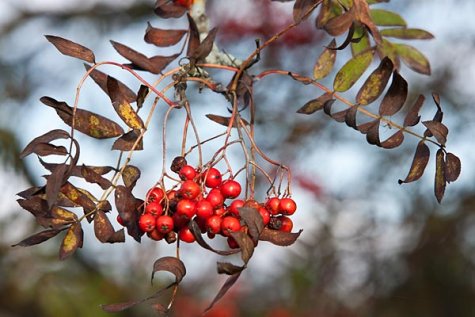Rowan berries become tastier with night frosts
Photo: Arne Ader
Translation: SilverT
Rowan berries
Rowan; mountain ash Harilik pihlakas Sorbus aucuparia
Clusters of rowan berries – to a botanist, this cluster is a corymb pome. And so it is - when this small fruit, less than a centimeter in diameter, is cut in half it looks like a miniature apple and the chemical composition is similar as well. There are three seeds in the fruit.
Rowan fruits become fully ripe with the first strong frosts: the taste becomes sweeter after frosts, there is less of the bitterish taste and the fruit is juicier.
What happened in the rowan berry? The cold caused some biochemical changes to take place: glucose and fructose was formed by hydrolysis, starches turned into into sugars and changes in pectins also occurred - the amount of soluble pectin increased and the non-soluble decreased. The proportions of malic acid and tannins decreased.
Quite significant changes can be noticed in rowan trees after night frosts. The clusters which used to be simple decorations are now an attraction for feathered creatures and also for others. Our largest forest creatures – brown bear and elk – feast on rowan berries as well.
We collect whole bunches of berries together with accompanying leaves and put them in the freezer overnight, to prepare juice or syrup or leave them in the freezer. Rowan berries contain large amounts of vitamins and other substances which are essential for the body.
The easiest way is to take ten rowan berries with a spoonful of honey – the size of the spoon is for the user to decide. A tablespoon is recommended.









